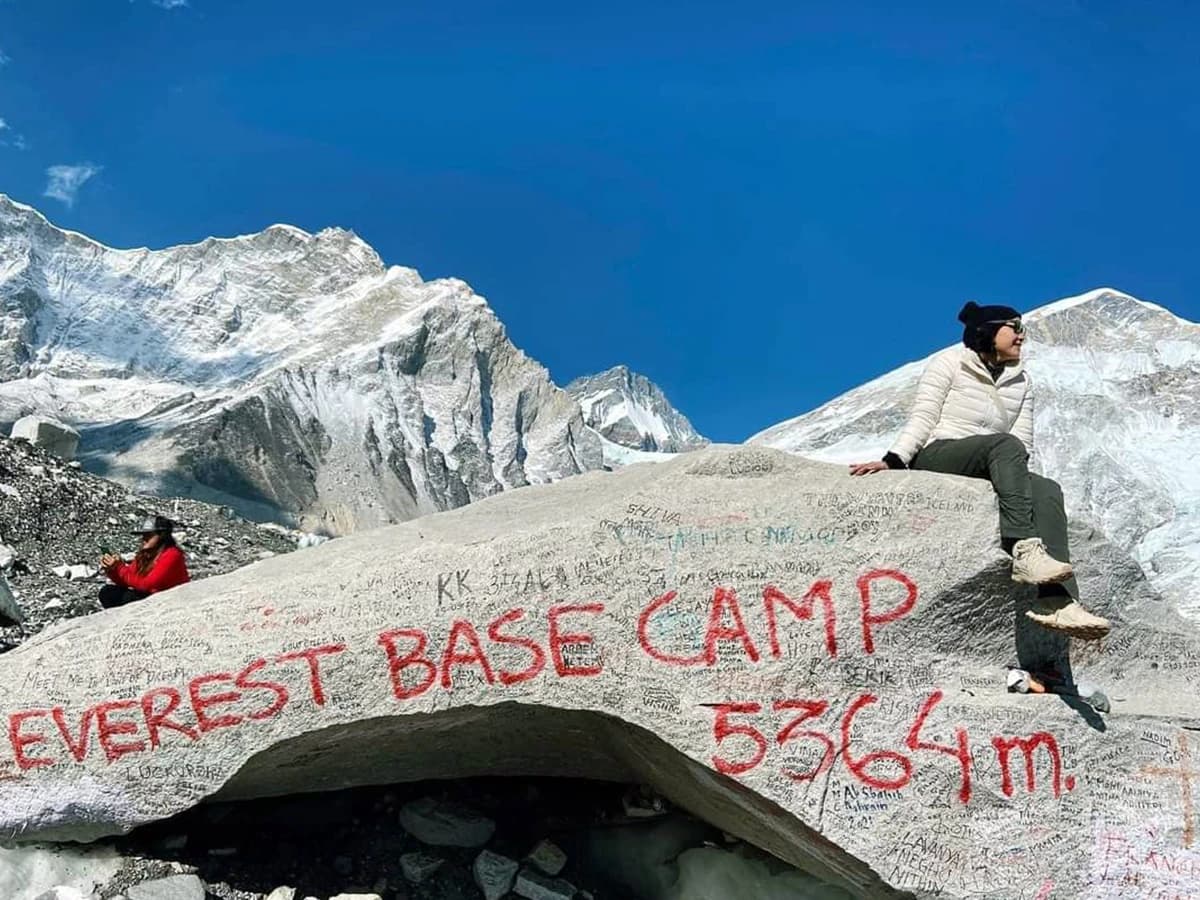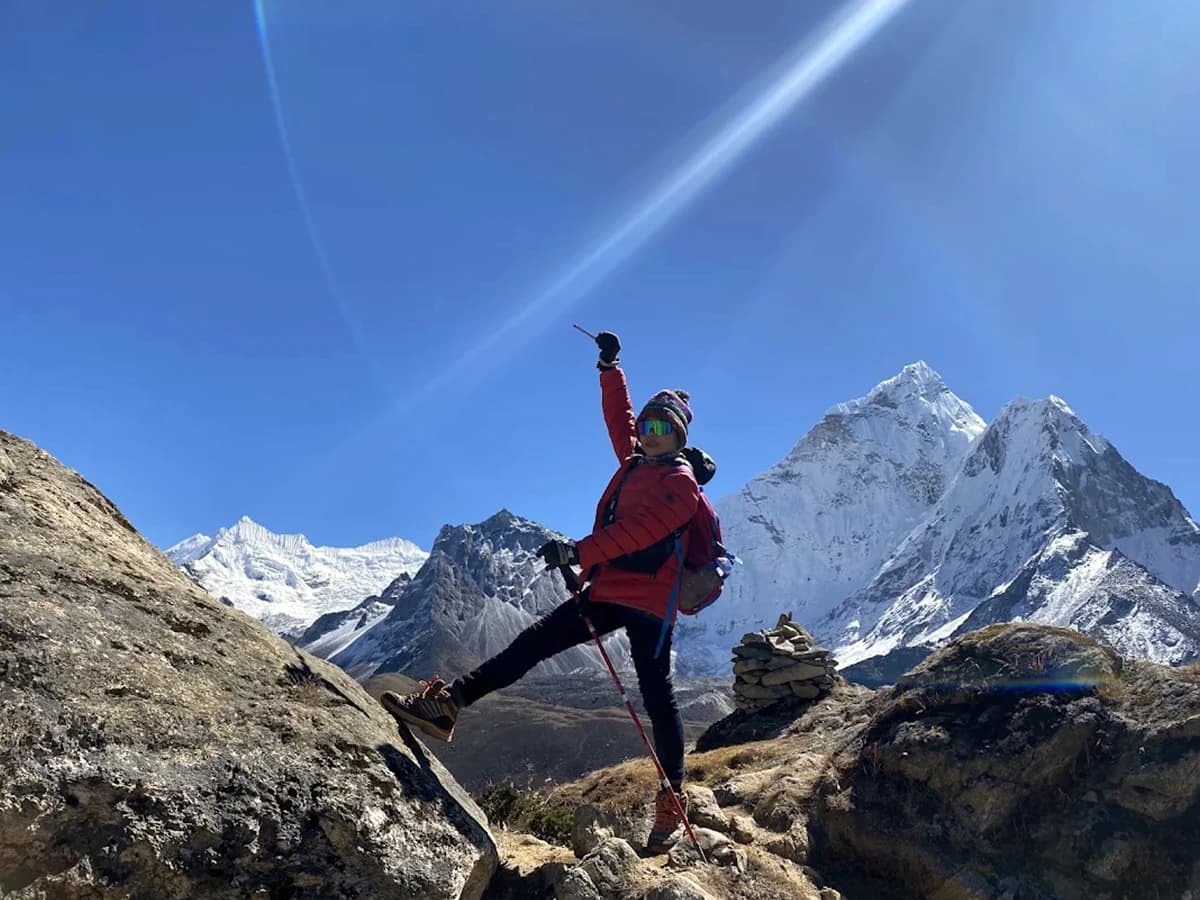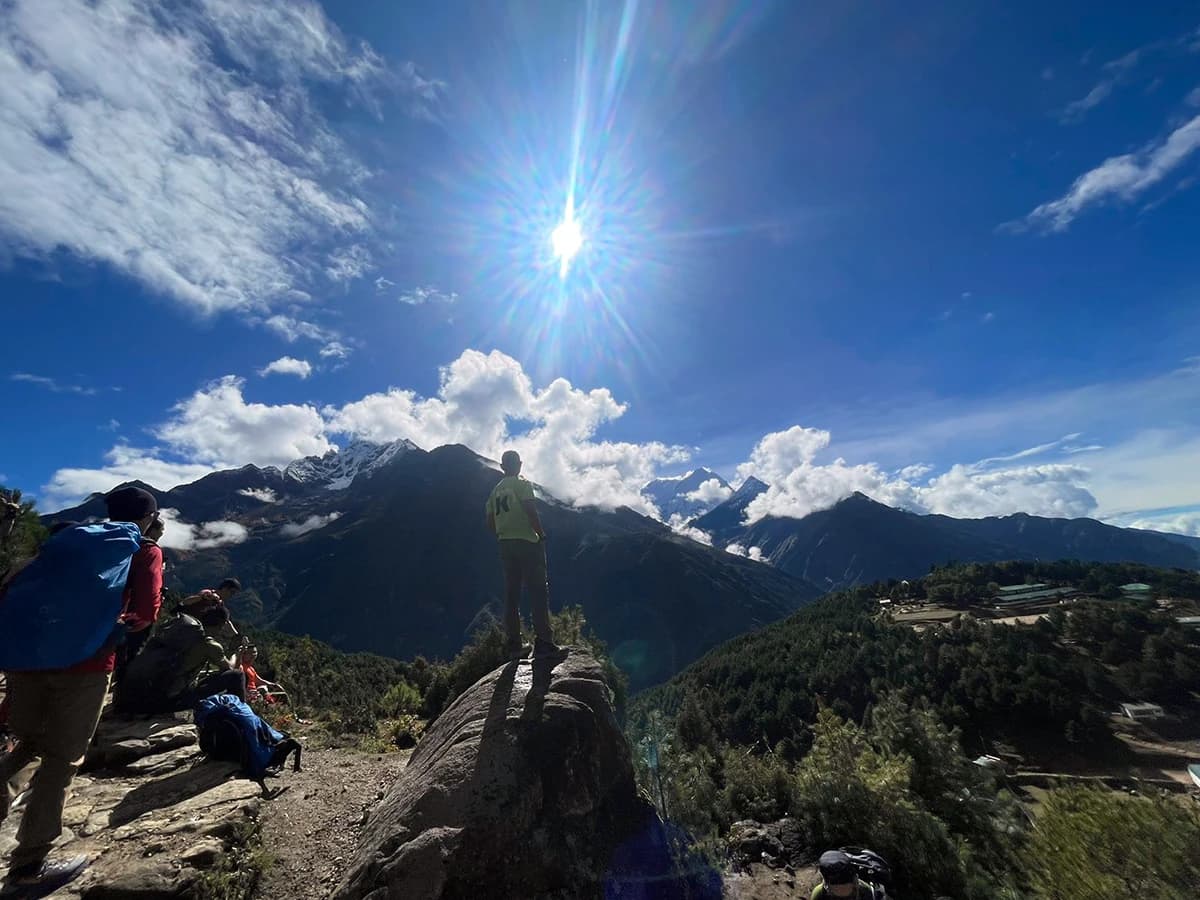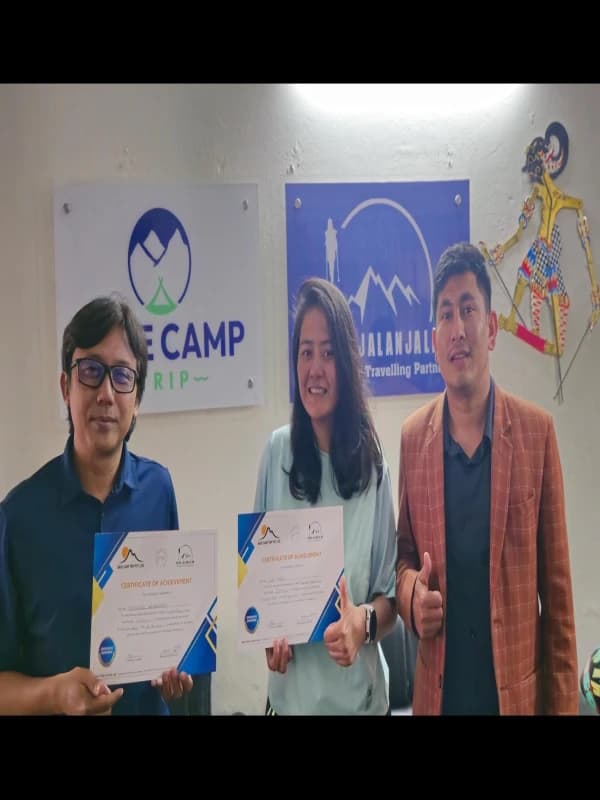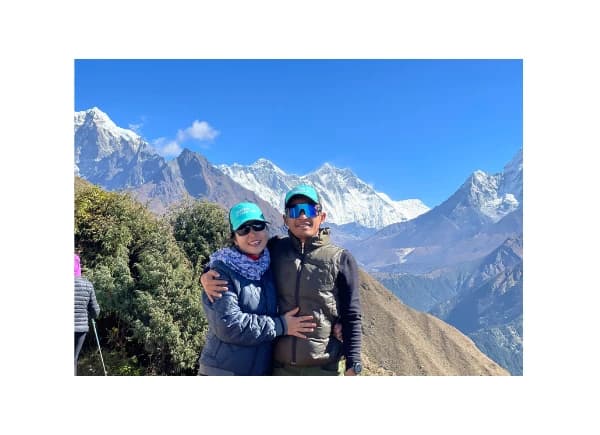Do you know that the Everest Base Camp trek is more than just an adventurous trip in the Himalayas? It is a journey through the vibrant streets of Kathmandu and bustling villages like Lukla and Namche Bazaar.
The trek tests your limits and demands you break free from modern laziness. You will push your physical and mental boundaries while hiking to the base of the tallest mountain in the world, Mount Everest.
Sharing the trails with thousands of trekkers from around the world, you will embark on a 14 days journey in Nepal that will change your life for real. In 14 days, you will spend 11 days hiking.
During those 11 days, you will walk 6 hours a day on average and eat simple mountain foods. It will allow your body to heal and revitalize by the end of the trek. Your body will not only feel light but also see a reduced number of scales.
With great adventure also comes great responsibility, so we ensure our trekkers only leave their footprint behind. Likewise, we greatly contribute to the local economy.
Are you planning to do this incredible trek? Are you ready to tick mark your Everest Base Camp trek from your bucket list and looking for a reliable Nepali trekking company? Then contact us. We, Base Camp Trip, offer the best Everest Base Camp cost and service.
What can you expect during the Everest Base Camp trek?
The Everest Base Camp trek is an adventure trip in the Khumbu region (Everest region). It is a multi-day hike through beautiful Sherpa villages, rhododendron forests, alpine meadows, and glacier moraines.
The goal is to reach Everest Base Camp on this trek, which takes eight days of walking through varying altitudes and climatic zones.
From Lukla, the starting point of the trek, you will traverse through lush forested hills and uneven hillsides along the Dudh Koshi River to Dingboche.
After Dingboche, the trail goes beyond the treeline. You will walk through high-altitude meadows, glacier fields, moraine, and rocky terrain.
The change in climate along the trail demands trekkers to be prepared for all kinds of temperatures and environments. Additionally, the rise in altitudes requires trekkers to acclimate as they move further.
Our Everest Base Camp trek itinerary has two acclimatization days that will help you a lot. Along with that, you also have to make sure you are not over-exerting yourself and resting enough.
You will trek with your guide and porter. They will be with you throughout the journey. Feel free to share with them if you feel sick or any discomfort. They will keep you entrained and well-informed.
We have shared things you can look forward to during the Everest Base Camp trek 14 days below:
- Everest Base Camp trek distance: On the Everest Base Camp trek, you will walk 130 kilometers in total. From Lukla to Everest Base Camp, the distance is 65 kilometers. Then, you will walk the same distance back to Lukla.
- Everest Base Camp trek map: We have customized the Everest Base Camp trek map according to our itinerary. You can find it attached below. Go through the map. It will help you understand the itinerary better.
- The bustle of Kathmandu: Though you will spend less time in Kathmandu, it will be an excellent part of your memory. The lights and bustle of Thamel, numerous shops, cafes, music, bars, and travelers from around the world will make your short time in this city remarkable.
- The Lukla flight: You will start and end the Everest Base Camp trek via the Lukla flight. Lukla is the gateway to the Everest region, and flying here is the quickest way to travel. The Lukla flight is famous for landing and take-off from a very short runway. Only propeller airplanes and helicopters fly in and out of this airport. The aerial views of the Himalayas are also outstanding during the flight.
- Sagarmatha National Park's flora and fauna: The Everest Base Camp trek route is located inside the Sagarmatha National Park. It has hundreds of plants, flowers, birds, and animals. Wild animals do not show up on human trails, but you will see many species of birds, insects, flowers, and plants.
- The adventurous trail: The Everest Base Camp trail ascends and descends throughout the way. You will cross many suspension bridges in the initial few days and explore streams and rivers. Likewise, in the upper part of the trail, you will explore alpine meadows, glacier moraines, etc.
- Sherpas: Sherpas are definitely one of the major highlights of Everest Base Camp trekking. They are the indigenous group of the Everest region and are famous for their kindness, resilience, and climbing ability. You will see their lifestyle, have many memorable interactions, and hear a lot of stories from them.
- Mountain vistas and landscapes: One thing you will not get tired of during the Everest Base Camp trek is the mountain views and landscapes. Every day, you will see different scenery and mountain vistas. Likewise, we also go on side excursions to the viewpoints from where you catch gorgeous sunrises and mountain panoramas.
- Welcoming locals and mountain lifestyle: The hospitality of Nepalese people is incredible whether you travel in the city or the mountains. The locals along the EBC trail are welcoming and friendly. They will treat you as their own. Likewise, you will see their unique mountain lifestyle.
Everest Base Camp trek difficulty
Trekking to Everest Base Camp is challenging but also achievable if you are well prepared. Average 6 hours of daily walking, rugged terrain, and high altitude are the three main challenges of this trek.
Though the Everest Base Camp trek does not involve technical climbing, it demands decent fitness. So, can a normal person do the Everest Base Camp trek? The answer is yes.
However, what you do before the trek starts and how well you understand the trek requirements overall shape your experience. For example, to walk 6 to 7 hours daily, you need to be in good shape.
So, if you are not someone who exercises or has good stamina, you should go on long walks to make a habit before the trek starts. Likewise, the Everest Base Camp route is not flat.
You will ascend and descend throughout the way. Again, it requires good strength and stamina. So, consider strength training and cardio activities like running, cycling, swimming, etc.
Anyone can do the Everest Base Camp trek, but they have to be physically fit. In addition, the Everest region is a remote area.
However, thanks to its popularity, the EBC trail has seen excellent development in the tourist infrastructure.
If you have a big budget, you can enjoy a luxury trek, which minimizes adjusting to a basic lodge, limited amenities, and sharing washrooms with other trekkers.
However, most trekkers do the standard Everest Base Camp trek, which requires many adjustments. If you are fine with that, then it's okay.
However, those who cannot cope with basic accommodation, shared washrooms, limited services, etc, may have a bit of a hard time.
So, what can you do? Save a little more money and do a luxury Everest Base Camp trek. This is the only solution.
Highlights
- An adventurous trip in the Himalayas of Nepal
- Trek to the base of the tallest mountain in the world, Mount Everest
- Start the journey through the vibrant streets of Kathmandu and trek through bustling Sherap villages
- Take thrilling Lukla flights
- Push your limits and test your endurance
- Trek through rhododendron-covered hills and cross numerous suspension bridges
- Get to know the Sherpa community closely and see their culture
- Enjoy high altitude environment and witness the Khumbu Glacier and Khumbu Icefall
- Go on incredible side hikes to see beautiful sunrises and stunning mountain vistas
- Explore ancient monasteries like Tengboche and Pangboche
- Hike to Kala Patthar to see the closest view of Everest
- Witness diverse landscapes and incredible mountain vistas throughout the trek
How to prepare for the Everest Base Camp trek?
To prepare for the Everest Base Camp trek, you can do the following things:
- Day hikes: Day hikes are a great way to practice uphill and downhill walking. It will also improve your stamina and let you adjust to higher altitudes.
- Strength training: You can visit the gym for strength training. Focus on strengthening your leg muscles, core, and shoulders. It will make walking long hours with a 5 kg backpack easy.
- Stamina and endurance: Cardiovascular activities like swimming, cycling, running, jogging, etc, will improve your stamina and endurance.
- Mental resilience: Trekking is also mentally challenging. You will need willpower to push yourself constantly. Likewise, you also need a positive attitude and patience. In short, you have to be determined to do the EBC trek.
Everest Base Camp trek permits and regulations 2025
Everest region is a protected area, and foreigners have to obtain permits to trek to Everest Base Camp. You will need the Sagarmatha National Park permit and the Khumbu Pasang Lhamu Rural Municipality Entrance permit for the EBC trek.
*Trekking without a necessary permit is illegal, and doing so will lead to fines and even a ban from entering the country.
- Sagarmatha National Park permit fee: NRP 3000 per person
- Khumbu Pasang Lhamu Rural Municipality Entrance permit fee: NRP 2000 per person
We request you to follow the below regulations during the Everest Base Camp trek:
- Do not litter the trail, and bring your waste down to Lukla to properly dispose of it.
- Use reusable water bottles during the trek, and avoid buying plastic water bottles.
- Respect locals and their customs. Do not impose your practices and mindset.
- Ask permission from the locals before taking their pictures.
- Do not enter kitchens in the lodges without permission from the owners.
- Follow our acclimatization plan.
Do you not want to trek back to Lukla? Combine a helicopter return to Kathmandu.
After hiking to Everest Base Camp and Kala Patthar, you have to follow the same trail back to Lukla. It will be another 65 km of descent and take three days.
Trekkers who do not want to spend another three days trekking back to Lukla can fly from Gorak Shep to Kathmandu in a helicopter.
It will not only save you three days but also let you escape the nerve-racking Lukla-Kathmandu flight.
It will cost around USD 650 to USD 750 per person to fly back to Kathmandu in a helicopter from Gorak Shep.
Guide and porter
Guide and porter are your on-field crew members. They do the Everest Base Camp trek with you.
The guide's main responsibility is to help you navigate challenging sections of the trail, show you the route, ensure your safety, and get you the best service in the lodges.
Porters are responsible for carrying your duffel bag during the trek. It allows you to walk without a heavy load.
Additionally, our guides and porters also motivate you and keep you entertained. Our one porter carries a duffel bag of two trekkers. Each trekker has an 8/9 kg weight limit.
How much should you tip your guide and porter? Is it necessary?
Tipping the guide and porter is a well-practiced culture. Trekkers tip their guide and porter to show appreciation for making their time safe, fun, and hassle-free in the mountains.
You can tip whatever you want. Tipping 15% to 20% of the package cost is a standard practice. However, you can tip more or less as per your satisfaction.
Do you have to spend any extra money apart from the Everest Base Camp trek package cost during the trip?
Our 14-day Everest Base Camp trek package includes expenses like accommodation in Kathmandu, accommodation and three meals a day during the trek, fees of guide and porter, EBC trek permits, Lukla flights, airport pick up/ drop off, and the company's service charge.
However, it doesn't cover expenses like travel insurance, flight to/from Kathmandu, lunch and dinner in Kathmandu, guide and porter tips, shopping, and personal expenses like charging, WiFi, hot shower, etc., during the trek.
Note that we provide accommodations as per our Everest Base Camp trek 14-day itinerary. If you have to stay an additional day because of an unexpected event, all the extra expenses must be handled by yourself.
After Namche Bazaar, there is no ATM, and the locals do not accept payment through card. So, we recommend trekkers carry some Nepali cash to buy additional services further along the way.
Why do the Everest Base Camp trek with the Base Camp Trip's team?
We, Base Camp Trip, have a high Everest Base Camp trek success and satisfaction rate. We work with the friendliest and funniest trek guides and porters who will literally enhance your trip.
Likewise, our acclimatization strategy goes beyond two rest days in our itinerary. Our guide will provide insider tips and advice on places to rest as you hike, which will increase your chance of acclimatization.
We provide hassle-free service, full support, transparent pricing, and many other facilities that will make your Everest Base Camp trek in Nepal unforgettable.
In addition to that, you can customize the Everest Base Camp trek itinerary with us. You can add destinations like Gokyo Lakes to your itinerary or even combine helicopter flights. Our private Everest Base Camp trek allows you to modify the journey as you wish.
Similarly, we do not compromise our trekkers' safety and comfort to fight for a competitive Everest Base Camp trek cost. Still, we guarantee the best service and a safe trip at the very best price.
It is a great time to book your Everest Base Camp trek 2025, autumn or winter departure. You can also place early bookings for the Everest Base Camp trek 2026 and start preparing.
Feel free to contact us if you have any questions.
